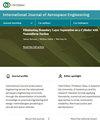A Modified Cycle Slip Detection Method with GNSS Doppler Assistance and Optimizing by Adaptive Threshold and Sliding Polynomial Fitting
IF 1.2
4区 工程技术
Q3 ENGINEERING, AEROSPACE
引用次数: 0
Abstract
Cycle slip determination plays an important role in high-precision data processing and application of global navigation satellite systems (GNSS). The TurboEdit method consists of the Melbourne-Wubbena (MW) and the geometry-free phase (GF) combination. It can correctly detect and repair cycle slip in most cases. Cycle slip detection (CSD) with GF is disturbed by severe ionospheric delay variations; moreover, CSD or cycle slip repair (CSR) with the MW faces the risk of the disturbance from large pseudorange errors. Hence, cycle slip determination would be difficult under some extreme conditions, e.g., cycle slips occur in low altitude satellite, low sampling rate of dual-frequency observations. To overcome the limitations, a new dual-frequency CSD and CSR method is proposed. The main contents are as follows: (1) compared with the MW method, the Doppler-assisted phase subtraction pseudorange (DAPSP) method that we proposed has no detection blind spot and can effectively reduce the influence of pseudorange noise at high sampling rates; thus, we replace MW by the DAPSP method to improve the detection accuracy. (2) An adaptive threshold model with root mean square (RMS) is established to effectively reduce the missing and false range detection of cycle slip. (3) The sliding polynomial fitting-assisted GF (SPFAGF) is carried out according to the satellite altitude angle. The trend of ionospheric delay and residual multipath effect error between adjacent epochs is extracted and suppressed by SPFAGF. The method combined with DAPSP and SPFAGF (DAPSP-SPFAGF) overcomes the situation that the TurboEdit method cannot effectively detect under extreme conditions. The experimental results of Beidou dual-frequency observation data show that the TurboEdit method and the DAPSP-SPFAGF method can perform CSD and CSR in most cases. At the sampling rate of 1 s, the detection speed of DAPSP-SPFAGF method is significantly faster than TurboEdit method. The number of false positives about CSD is reduced from 68 to 0. At the sampling rate of 30 s and under the condition of the observed satellite altitude angle below 30°, the false alarm rate of the DAPSP-SPFAGF method is 0, but the TurboEdit method’s false alarm rate is 71.2%. So DAPSP-SPFAGF method is prior to the TurboEdit method at the high sampling rates or under extreme conditions, especially it can accurately detect and repair cycle slip and reduce the false positives and false alarm rate.一种改进的GNSS多普勒辅助周跳检测方法及自适应阈值和滑动多项式拟合优化
周滑确定在全球导航卫星系统的高精度数据处理和应用中发挥着重要作用。TurboEdit方法由Melbourne Wubbena(MW)和几何自由相(GF)组合组成。在大多数情况下,它可以正确地检测和修复循环打滑。GF的周滑探测受到电离层严重延迟变化的干扰;此外,具有MW的CSD或周滑修复(CSR)面临着来自大伪距误差的干扰风险。因此,在某些极端条件下,周期滑动的确定将是困难的,例如,在低空卫星中发生周期滑动,双频观测的低采样率。为了克服这些限制,提出了一种新的双频CSD和CSR方法。主要内容如下:(1)与MW方法相比,我们提出的多普勒辅助相位相减伪距(DAPSP)方法没有检测盲点,在高采样率下可以有效地减少伪距噪声的影响;因此,我们用DAPSP方法代替MW来提高检测精度。(2) 建立了一种均方根自适应阈值模型,有效地减少了周跳的漏检和误检。(3) 根据卫星高度角进行滑动多项式拟合辅助GF(SPFAGF)。SPFAGF提取并抑制了相邻历元之间电离层延迟和残余多径效应误差的趋势。将DAPSP和SPFAGF相结合的方法(DAPPS-SPFAGF)克服了TurboEdit方法在极端条件下无法有效检测的情况。北斗双频观测数据的实验结果表明,TurboEdit方法和DAPPS-SPFAGF方法在大多数情况下都可以执行CSD和CSR。以1的采样率 s、 DAPPS-SPFAGF方法的检测速度明显快于TurboEdit方法。关于CSD的假阳性数量从68减少到0。以30的采样率 s,在观测卫星高度角小于30°的条件下,DAPPS-SPFAGF方法的虚警率为0,而TurboEdit方法的虚报警率为71.2%。因此,在高采样率或极端条件下,特别是能够准确地检测和修复周跳,降低误报率和误报率。
本文章由计算机程序翻译,如有差异,请以英文原文为准。
求助全文
约1分钟内获得全文
求助全文
来源期刊

International Journal of Aerospace Engineering
ENGINEERING, AEROSPACE-
CiteScore
2.70
自引率
7.10%
发文量
195
审稿时长
22 weeks
期刊介绍:
International Journal of Aerospace Engineering aims to serve the international aerospace engineering community through dissemination of scientific knowledge on practical engineering and design methodologies pertaining to aircraft and space vehicles.
Original unpublished manuscripts are solicited on all areas of aerospace engineering including but not limited to:
-Mechanics of materials and structures-
Aerodynamics and fluid mechanics-
Dynamics and control-
Aeroacoustics-
Aeroelasticity-
Propulsion and combustion-
Avionics and systems-
Flight simulation and mechanics-
Unmanned air vehicles (UAVs).
Review articles on any of the above topics are also welcome.
 求助内容:
求助内容: 应助结果提醒方式:
应助结果提醒方式:


